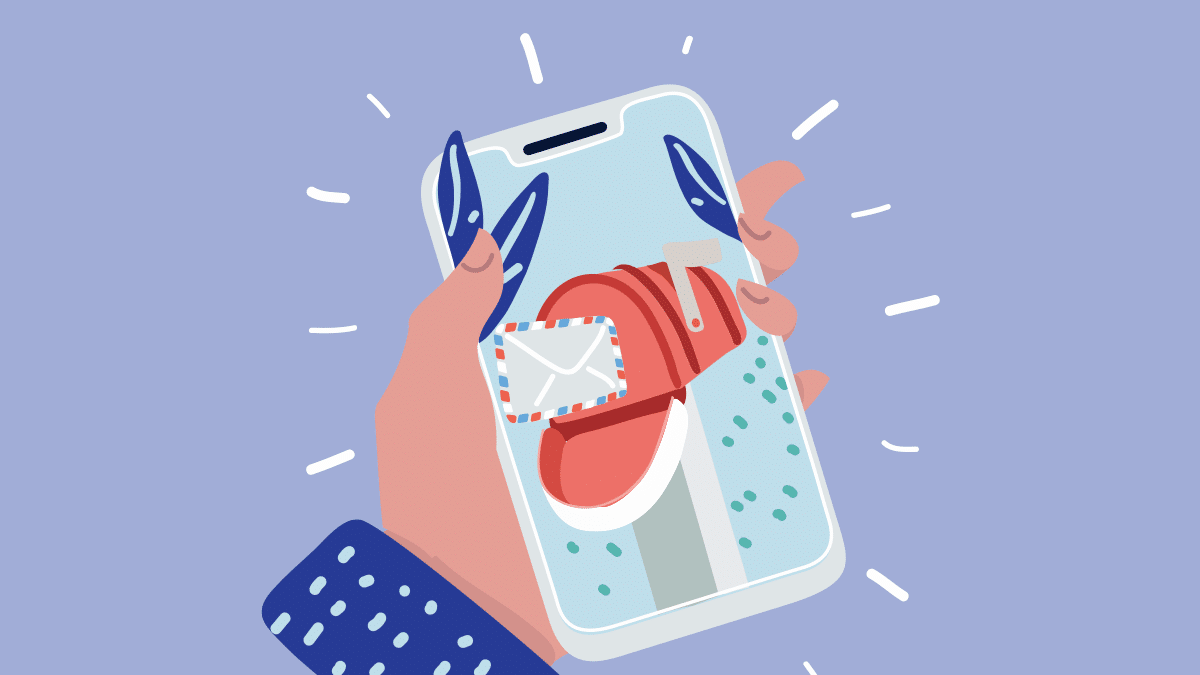For small businesses, attracting new customers with a limited budget can be… tricky.
Every penny spent on marketing must be worth it, and you need to know that you’ll get a return on your investment. This might explain why email continues to be the main channel used by small companies to drive business. A study by Emarsys found that 81% of small to medium-sized businesses rely on email as their primary customer acquisition channel, and 80% of those businesses also use email to retain their customers.
But it’s important to remember that there are different ways of doing email marketing to achieve different goals. For example, if you’re trying to drive new business, you need to use a different tactic than if you’re selling a new product. In this guide, we’re going to take a deeper look at:
- What is email marketing, and why do businesses use it?
- 7 email marketing examples for businesses on a budget
- How to do email marketing well (with limited budget and time)
- What is the best email marketing software?
Let’s dive in.
📥 Are you over email? If you hit at least one of the points on our checklist, it’s time to consider an email alternative.
What is email marketing, and why do businesses use it?
Email marketing is a digital strategy that businesses use to attract (and keep) customers and subscribers.
Depending on how effective your emails are, you can turn window shoppers into paying customers, and subscribers into loyal, word-of-mouth marketing fans. More importantly, email marketing is a smart, efficient investment for small business owners. A study by DMA found that for every $1 a company spends on email marketing, they can expect an average return of $42.
Here are a few other benefits:
- Email remains the most effective communication channel: An OptinMonster survey found that a whopping 99% of consumers check their email every single day, with some people refreshing their inboxes up to 20 times a day. It’s also checked before other forms of communication—including even the news and social media.

- It builds and strengthens your customer base: Email is a way to communicate with your customer on a personal level—it’s part of the customer experience. You can tailor emails to each person, and unlike social media ads, you own your email list. Those leads are yours to keep in your database, and you can use email marketing to build a relationship with them.
- It’s the best way to turn people into customers: No matter what kind of email marketing you’re using, it’s still the best way to turn people into customers. An Experian report found emails that are geared towards transactions have 8x more opens and clicks than any other type of email. The best part? This translates into cold hard cash: they can generate 6x more revenue too.
Simply put, spam emails and requests from Nigerian princes for wire transfers aside, email is still the best way for companies to make sales online. And it can drive business, even if your company is a brick-and-mortar.
There are two other factors that explain why email marketing is so good at driving sales.
1. Email marketing builds relationships
Email is one of the best ways to reach out to your customers and strengthen relationships.
A stronger relationship not only helps businesses cut churn (i.e., when customers stop buying your product), but it’s also key to driving new sales. A study by Nielsen found that 66% of customers are more likely to buy new products from brands they know well rather than unfamiliar companies.
Not only that, emails are still one of the most effective forms of one-to-one communication. Sure, it’s not quite as personal as phone calls, but it’s way more efficient—you can send thousands of customized emails at once, but you can only take one inbound call at a time.
OutboundEngine’s Travis Balinas says that the long-term nature of email marketing is key for many businesses, from mortgage brokers to insurance agents and promotional products distributors, which all rely on building up strong personal relationships to drive revenue.
“The whole idea behind building relationships through email is that the pay off doesn’t have to be right then and there, meaning that just because you send an email, doesn’t mean instant business. These effective communication practices help you build these relationships over time, increasing loyalty, and nurturing these people to become even more valuable.”
2. Email marketing directly affects growth multipliers
Let’s lift the hood of the economics behind email marketing.
Veteran marketer Jay Abraham put revenue growth on the map with his theory that it is influenced by only three factors:
- Contribution margin (including the average order value, or AOV): The price of a product once you subtract all of its associated costs
- Conversion rate: How many prospects turn into paying customers
- Repeat transactions: When a customer decides to buy from your business more than once
It’s all about the numbers. If you can move the needle on your customer numbers or increase the AOV of the customers already buying your products, you’ll grow.

An example of Abraham’s theory in practice.
Now, the reason this theory is essential to what we’re talking about here is that email marketing can cover all three growth levers at the same time. For example, a way to increase your conversion rates may be to send welcome emails or promotional emails. And if a business wants to boost its customers’ AOV, it can highlight a new product release or try cross-selling in an email.
7 email marketing examples for businesses on a budget
1. Newsletter emails
Newsletters are a great way to keep people on your email list up to date with your company’s blog content, events, updates, and announcements.
Newsletters are usually split into different sections so companies can highlight a couple of different announcements in one email. Think of it as a way to kill two birds with one stone without spamming your customers’ inboxes. Newsletters usually follow a standard format and a regular calendar:
- Image paired with a headline
- Summary of what the email is about
- A call-to-action (CTA) or two
Here’s an email example from The Orchard, an agency out of Australia:
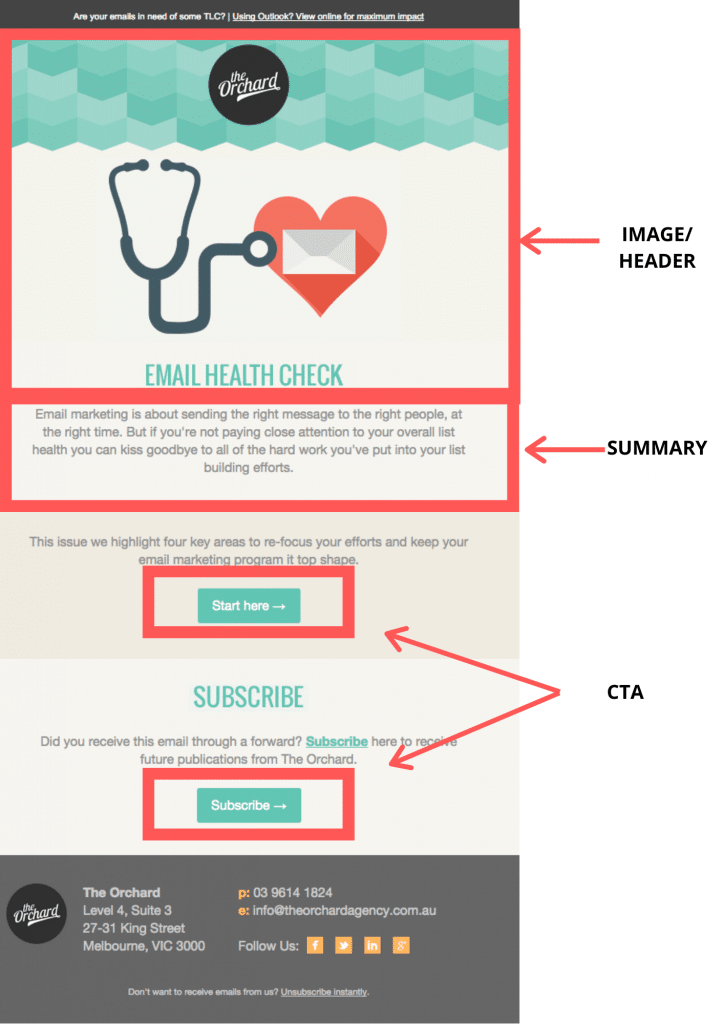
Typically, newsletters are used as a way to nurture customer relationships and educate your readership as opposed to selling a product.
Pro-tip:
Don’t go overboard with CTAs, as putting too many on your emails can decrease how many clicks you get. Having more than two CTAs can ultimately lower how well your audience engages and interacts with your email content. Case in point: home appliance company Whirlpool. They managed to increase their email click-through rates by 42% just by cutting their CTAs down from four to one.
2. Promotional emails
Promotional emails are one of the more common ways in which businesses use email to drive sales.
And customers love them too. Statista found that 49% of customers like receiving promotional emails from companies on a weekly basis. These emails typically focus on either giving a customer a limited-time offer or use content to promote a product. You can frame your promotional emails by:
- Offering discounts/promotions
- Adding a countdown timer to increase urgency
- Giving a free sample/product
- Using color, images and fonts that grabs attention
- Using value-based content (e.g. blogs, recipes, how-to guides) to drive sales
Here’s an example of how Cava promotes its dip selection at Whole Foods:
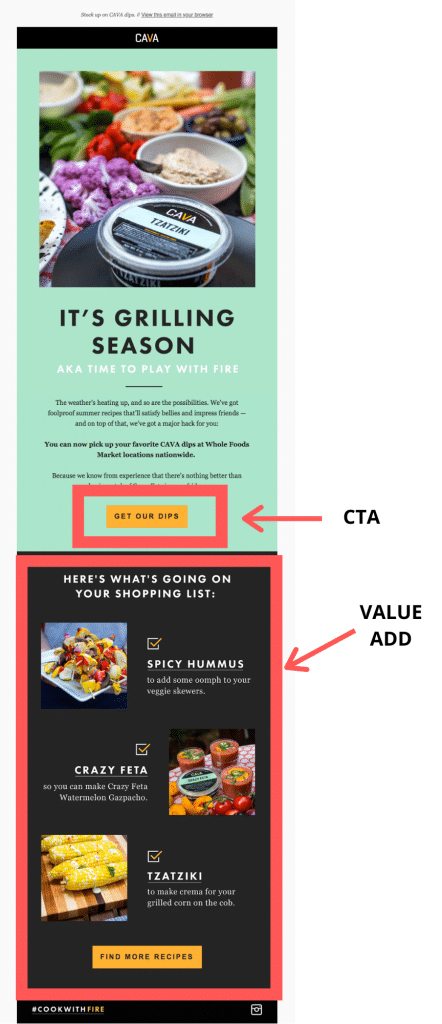
You can see why subscribers and customers might like this email, even though it’s selling a product—underneath the product promotion, the company has added useful recipes for how to use their dips.
3. Welcome emails
Welcome emails are the perfect way for small businesses to capitalize on new customers or subscribers. (Learn more about how to create the perfect welcome email.)
A GetResponse study found that the average open rate for welcome emails is 82%, which means unlike most emails out there, these actually get opened—making them an ideal way for your business to make a good impression from the start. Typically, welcome emails will highlight your company’s personality and give your new subscriber or customer a taste of what you’re all about.
If a customer has purchased a product, you can use a welcome email to explain how it works and help them get started. Or if they’re a new subscriber, you can take the opportunity to tell your company’s story and how your product can help them reach their goals. Here’s an example of a warm and inviting welcome email from Headspace:
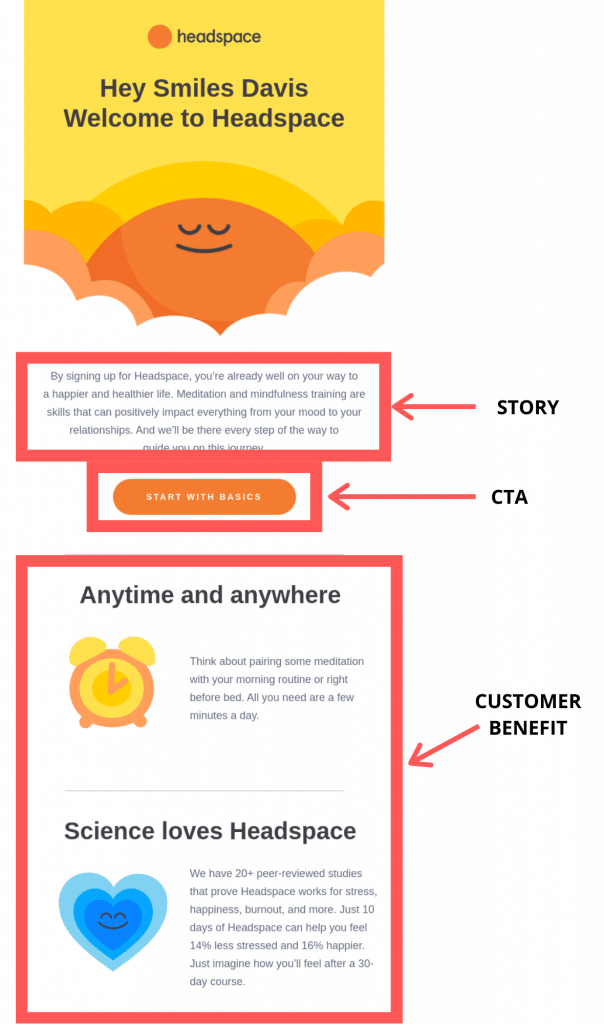
4. Content emails
If you create blog posts or eBooks, emails are a great way to boost your readership.
You can use an email to drive traffic to a single post or highlight a bunch of content at once. For example, Help Scout uses email to send out a “greatest hits” collection of their favorite blog posts of the year:
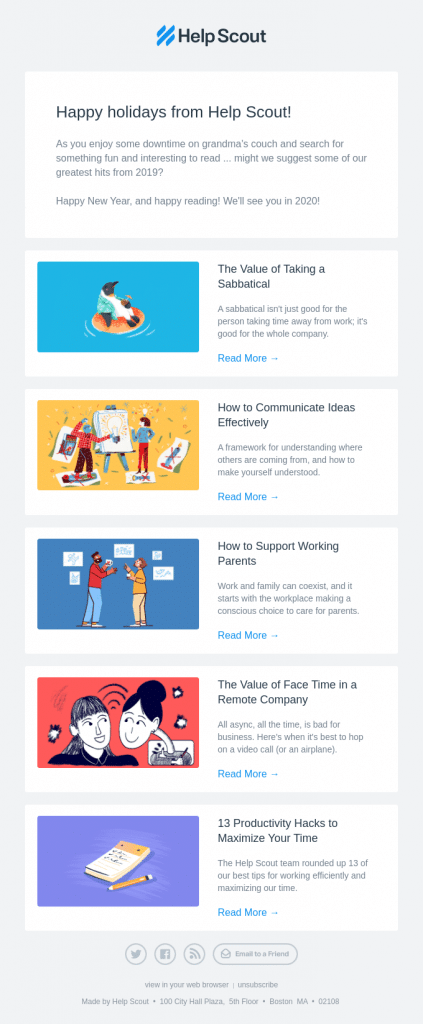
Not only does this add a ton of value to readers’ inboxes, it also makes sure readers don’t forget about the brand during the holidays!
5. Product update emails
If you’re making changes to your product or service, it’s crucial these are communicated to your customers.
Emails are a quick and easy way to let your customers know the latest changes and feature updates, and more importantly, how they’ll benefit. A lot of businesses choose to send out product updates periodically—i.e., not every week—so they don’t flood their customers’ inboxes.
Take a look at how Dovetail does it. This email, which was sent in August, lets their customers know that they’ve added a couple of new features since their last update:

Here’s what we love about this update.

The new features are summarized in a paragraph, which makes it easy to digest. If the customer wants to learn more about how they’ll benefit from the update, they can click on the CTA directly underneath the announcement:
If you want to replicate this formula in your own product email updates, all you have to do is:
- Have a clear headline for each product update
- Describe the benefits (not just the features)
- Showcase an image if it’ll help your customers visualize the update/change (it probably will)
- Provide a CTA so they can click through to a blog post or web page to learn more about the update
6. Events emails
Emails, especially if your business has a brick-and-mortar location, are ideal for promoting events like parties and in-store sales.
Event emails can be used to drive a crowd to tradeshows, new restaurant openings, and even product launches. The reason they work so well is you can include a digital RSVP or ticket purchase option, which makes it a little easier to keep track of attendance numbers.
Australian digital agency, Liquorice, used email marketing to celebrate their studio expansion as well as enjoy Christmas with their customers. The email invite worked for several reasons:
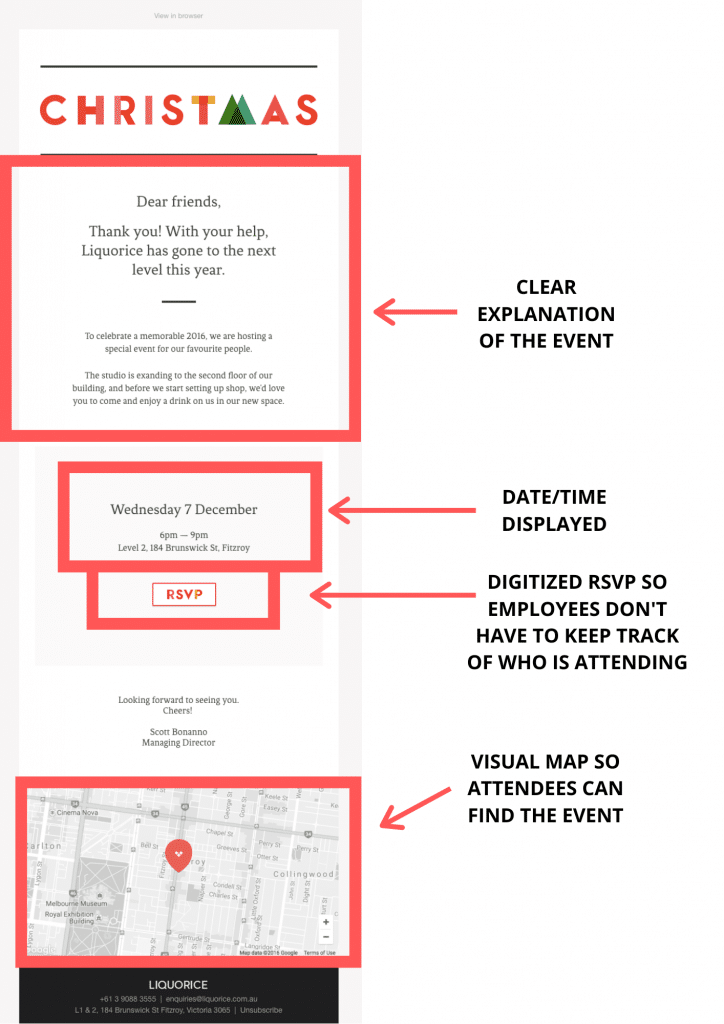
7. Abandoned cart emails
Lastly, email marketing can chase after customers who abandoned their cart before completing their purchases.
Abandoned cart emails are usually triggered automatically using email marketing software. If you’ve invested in the right email software (which we’ll get into below), you’ll be able to track a customer’s order, and in turn, trigger an email sequence to remind them to check out if they abandon their cart before making a purchase.
The most effective abandoned cart emails remind customers what they left behind, like this one from Beardbrand:
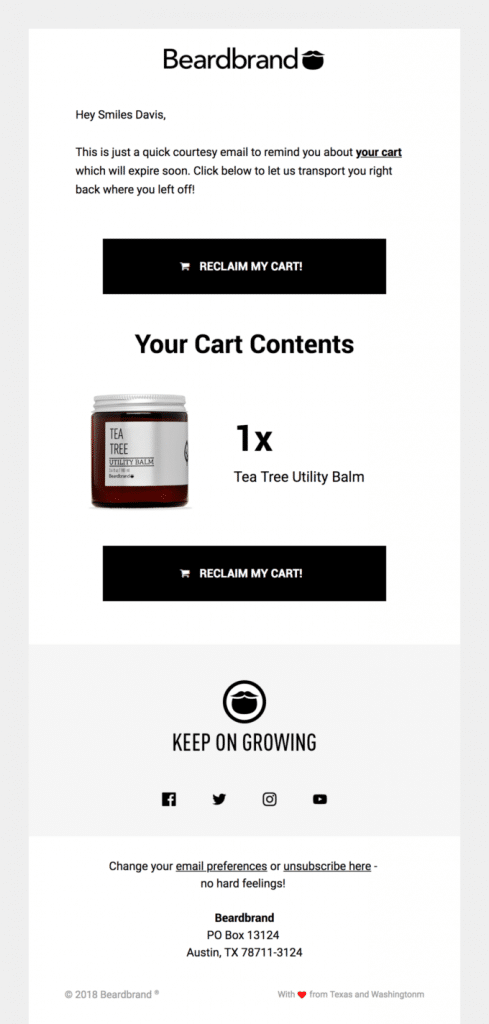
How to do email marketing well (with a limited budget and time)
You don’t have time to spend all day piecing together a perfect email marketing campaign. That’s okay.
The reason email marketing is so great is because you don’t have to send one out every single day. Mailchimp‘s content strategist Kate Kiefer Lee says you should only send an email if you’ve got something to say.
“This one seems obvious, but too many companies start email newsletters with no plan and nothing to say,” she says.
“Email is simply a way to publish content—the content itself has to come first.”
Before pushing the send button on an email campaign, Lee recommends asking yourself:
- What goal are you hoping to achieve by communicating?
- What do you have to say?
- How will you measure the success of the email?
Apart from not having to spend all of your time on email marketing, there’s another reason why it’s perfect if you’re managing a small business: workflow automation. According to the Epsilon Email Institute, automated emails have a 70.5% higher open rate than standard marketing messages, along with a 152% higher click-through rate.
Which is strange, because, shouldn’t automatic emails perform more poorly? After all, they’re… automated.
Well, not exactly.
The rise of all-in-one email marketing automation platforms means even busy small business owners can use pre-designed email marketing templates and sequences to send out professional-looking campaigns in just a few clicks. Ultimately, this gives you a unique—and low-effort—way to build relationships with your customers.
Email automations are usually used for targeted emails (like promotional emails) or “triggered” emails (like welcome emails). For example, you can build a welcome email campaign to send automatically using a sequence like this:

ThoughtLab’s Tonya Davis says you should also make it easy for people to subscribe to your email marketing lists.
“You want to avoid form fatigue by keeping things simple, clear, and concise. Make your subscribe button noticeable and easy to find,” she says.
Basically, do your best to remove any friction in your sign-up process. Friction can be anything from a CTA button that’s in a hard-to-see color to asking for too much information in the sign-up form. The less information you ask for, the easier it is for them to sign up.
Pro-tip:
Even with marketing automation, you might want to stick to a publishing calendar so you don’t forget about sending emails altogether. If you’re sending out a weekly or monthly newsletter, you’re committing to that cadence. If you miss a few newsletters here and there, your subscribers might forget about you and lose interest in your brand. Make time at the start of each month or quarter to plan, write, design, and set up your email campaigns.
What is the best email marketing software?
Like any software, the range of email marketing tools out there means you have to research which one is right for your business goals—and budget.
Email marketing software on a budget: Mailchimp
Mailchimp is on top of the list for a lot of reasons.
First off, it’s free. With Mailchimp’s Forever Free plan, you can send 12,000 emails a month to up to 2,000 subscribers, which is a perfect starting place for small businesses. Although the free plan doesn’t include features like advanced segmentation (aka grouping your subscribers by certain traits) and send-time optimization, it’s more than enough if you just want to send out monthly newsletter campaigns.
The free plan comes with customizable templates too, so you can build beautiful emails simply by dragging and dropping:
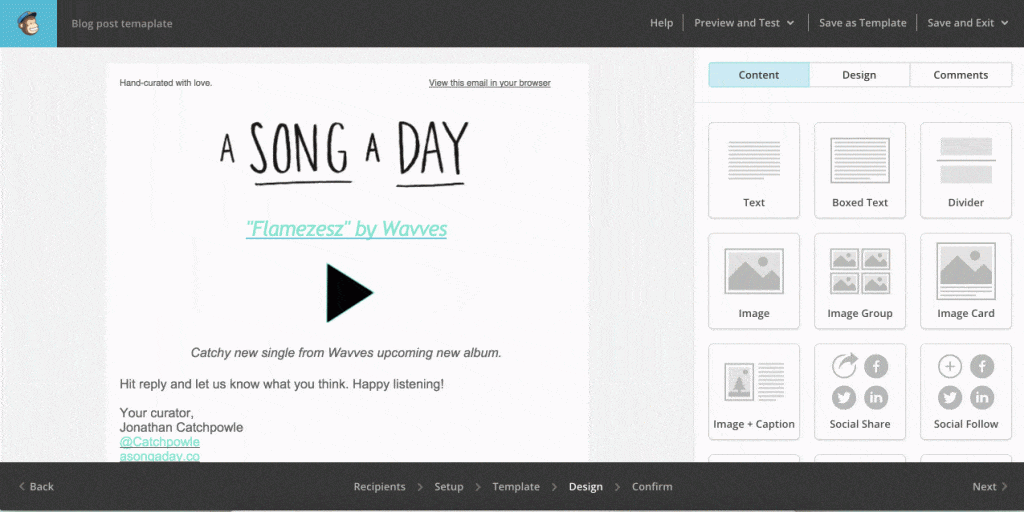
Mailchimp’s drag-and-drop email builder
Mailchimp also integrates with WordPress as well as eCommerce platforms like Magento and Shopify. And if you need help, you can reach out to their support team over email and live chat or search the knowledge base for tips.
Price: The Forever Free plan includes 12,000 emails/month for up to 2,000 subscribers. Paid plans start from $10/month for up to 500 additional subscribers.
Pro-tip:
If most of your sales are made over the phone, you can still use Mailchimp to reach out to customers. For example, RingCentral’s cloud phone system integrates with Mailchimp so you can track your email newsletters and contact leads while the iron is still hot.
Email marketing software for triggered campaigns: Drip
Drip is one of the best tools on the market if you want to step up your email marketing game with personalization.
The platform’s marketing automation tools allow you to send segmented email campaigns using a snazzy visual workflow builder, no coding skills needed. It’s a great way to create triggered email workflows and create custom triggers for when you want a customer to be sent new content:

An example of Drip’s visual email marketing builder.
Drip’s dashboard also tracks how long it took for someone to make a purchase after signing up to your email list, as well as when emails were opened. You don’t have to be a big corporation with deep pockets to send bulk emails and engage with every customer on your list personally!
Price: Free trial. Plans start at $49/month, including all their features.
Email marketing software with no learning curve: GetResponse
GetResponse is an email marketing software built specifically for small businesses and non-tech-wizards. It stands out because it’s extremely easy to use and simplifies complex email marketing sequences with its campaign builder:

The drag-and-drop builder also lets you create campaigns and segment contacts easily. This means you can send out specific promotions or content to groups of contacts who will benefit from it most.
As well as tracking interactions with readers and sending autoresponders, GetResponse also integrates with other useful software like OptinMonster, Google Docs, and Zendesk.
Price: Free trial. Pricing starts at $15/month.
Use these email marketing examples to grow your business
When it comes to growing your sales and building relationships with customers, few marketing channels can match up with email marketing.
The data is clear. Most people read their emails every day, and emails are still at the top of the marketing list for creating conversions. It’s perfect if you’re low on budget and time, the risk is low, and you can easily automate it. With so many tools out there at every price point, you can send monthly newsletters, upsell emails, and promotional offers automatically—all for free.
So what are you waiting for? Start collecting email addresses and put together a simple email campaign. Then, let email marketing software take over and help you build and nurture those relationships. Before you know it, you’ll be turning readers into paying customers.
Originally published Feb 22, 2020, updated Apr 18, 2021
